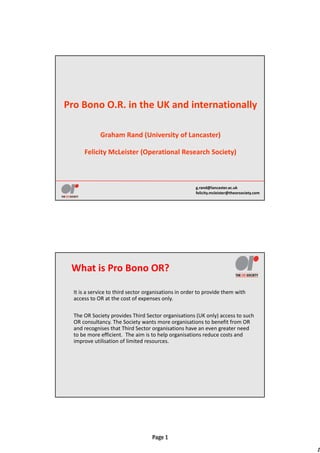IFORS Pro Bono O.R. presentation 2014
- 2. 2 Page 2 The¬†ORS¬†initiative In¬†December¬†2012,¬†the¬†ORS¬†Board¬†agreed¬†to¬†(i)¬†continue¬†with¬†an¬†existing¬† volunteer‚Äźrun¬†Pro¬†Bono¬†initiative,¬†and¬†(ii)¬†employ¬†a¬†paid¬†coordinator. The¬†Board¬†had¬†some¬†doubts¬†about¬†the¬†viability¬†of¬†the¬†scheme¬†(e.g.¬† whether¬†enough¬†volunteers¬†could¬†be¬†found).¬†There¬†were¬†also¬†issues¬† around¬†the¬†ability¬†of¬†the¬†ORS¬†to¬†fund¬†this¬†for¬†the¬†long¬†term.¬†Therefore,¬†the¬† initial¬†appointment¬†of¬†a¬†paid¬†coordinator¬†was¬†for¬†a¬†fixed‚Äźterm¬†of¬†one¬†year. The¬†coordinator,¬†Felicity¬†McLeister,¬†started¬†in¬†September¬†2013.¬†¬†As¬†a¬†result¬† of¬†the¬†success¬†of¬†her¬†work,¬†her¬†appointment¬†has¬†recently¬†been¬†extended. The¬†aims¬†of¬†the¬†ORS¬†pro¬†bono¬† scheme¬†are: 1. To¬†help¬†organisations¬†in¬†the¬†3rd sector¬†(e.g.¬†charities¬†and¬†social¬† enterprises)¬†to¬†do¬†a¬†better¬†job 2. To¬†promote¬†OR¬†in¬†the¬†third¬†sector 3. To¬†give¬†OR¬†analysts¬†an¬†opportunity¬†to¬†practise¬†in¬†a¬†wider¬†arena¬†and¬† widen¬†their¬†skills
- 5. 5 Page 5 What¬†has¬†been¬†achieved ‚ÄĘ 6¬†completed¬†projects,¬† ‚ÄĘ 10¬†active¬†projects,¬† ‚ÄĘ several¬†others¬†in¬†the¬†initial¬†inquiry¬†stage. Volunteer¬†recruitment Felicity¬†maintains¬†the¬†volunteer‚Äôs¬†database¬†and¬†keeps¬†in¬†touch¬†with¬†volunteers¬† regularly.¬†¬†She¬†has¬†recruited¬†94¬†new¬†volunteers.¬†¬† Note:¬†The¬†reason¬†for¬†the¬†fluctuation¬†in¬†numbers¬†is¬†linked¬†to¬†the¬†timing¬†of¬†the¬†members‚Äô¬†mail¬†out¬†and¬†the¬† months¬†where¬†Felicity¬†has¬†focused¬†on¬†increasing¬†the¬†volunteers.¬†¬†It¬†is¬†important¬†to¬†keep¬†the¬†balance¬†between¬† the¬†numbers¬†of¬†volunteers¬†and¬†the¬†number¬†of¬†projects¬†so¬†this¬†is¬†done¬†on¬†an¬†ad¬†hoc¬†basis¬†when¬†required.
- 6. 6 Page 6 Here¬†is¬†what¬†some¬†of¬†those¬†who‚Äôve¬† received¬†Pro¬†Bono¬†support¬†have¬†said: ‚ÄĘ Crimestoppers:¬†‚ÄėWe‚Äôve¬†benefited¬†hugely¬†from¬†your¬†work¬†and¬†support¬†in¬† all¬†areas¬†of¬†the¬†project.¬†And¬†from¬†an¬†organisational¬†perspective¬†you‚Äôve¬† enabled¬†us¬†to¬†take¬†a¬†highly¬†professional¬†approach¬†to¬†increasing¬†the¬† efficiency¬†of¬†our¬†charity.‚Äô¬†(Performance¬†Manager) ‚ÄĘ Participle:¬†‚ÄėI¬†have¬†just¬†started¬†to¬†digest¬†the¬†work¬†you¬†did¬†for¬†us¬†and¬† wanted¬†to¬†say¬†a¬†huge¬†thank¬†you. This¬†will¬†be¬†so¬†critical¬†to¬†our¬†growth¬† and¬†I¬†am¬†very¬†grateful¬†indeed¬†for¬†your¬†time¬†and¬†expertise. The¬†team¬† have¬†described¬†you¬†as¬†‚Äúa¬†joy¬†to¬†work¬†with‚ÄĚ.‚Äô¬†(Principal¬†Partner) ‚ÄĘ The¬†Cardinal¬†Hume¬†Centre¬†‚ÄėWe¬†valued¬†the¬†opportunity¬†to¬†work¬† collaboratively¬†and¬†without¬†doubt¬†benefited¬†from¬†the¬†analyst‚Äôs¬† expertise¬†and¬†commitment¬†to¬†the¬†project.‚Äô¬†(Operations¬†Director) What¬†are¬†the¬†wider¬†results OR¬†is¬†understood,¬†valued,¬†demanded¬†and¬†used Pro¬†Bono¬†OR¬†has¬†appeared¬†in¬†newsletters¬†of¬†different¬†charity¬†umbrella¬†bodies¬† which¬†between¬†them¬†have¬†circulation¬†of¬†over¬†100,000,¬†and¬†presented¬†a¬† workshop¬†at¬†a¬†voluntary¬†organisation¬†conference¬† ORers are¬†knowledgeable,¬†well‚Äźtrained,¬†in¬†good¬†supply Pro¬†Bono¬†OR¬†gives¬†opportunities¬†to¬†practise¬†and¬†develop¬†skills¬†in¬†new¬†settings.¬†¬† It¬†offers¬†structures¬†for¬†inexperienced¬†analysts¬†to¬†be¬†supported¬†or¬†led¬†by¬†a¬† more¬†senior¬†analyst,¬†providing¬†opportunity¬†for¬†development¬†and¬†learning.¬† It¬†generates¬†material¬†for¬†conference¬†streams¬†and¬†SIG¬†meetings,¬†to¬†support¬† these¬†learning¬†and¬†development¬†activities. It¬†provides¬†opportunities¬†for¬†members¬†who¬†are¬†not¬†currently¬†employed¬†in¬†OR¬† roles¬†to¬†‚Äėkeep¬†their¬†hand¬†in‚Äô. By¬†promoting¬†OR¬†in¬†this¬†field,¬†the¬†ORS¬†may¬†attract¬†people¬†into¬†OR¬†who¬†would¬† not¬†otherwise¬†have¬†considered¬†the¬†profession.
- 7. 7 Page 7 Costs The¬†cost¬†to¬†the¬†ORS¬†of¬†running¬†the¬†scheme¬†is¬†currently¬†around¬†¬£30,000¬†p.a.¬† The¬†key¬†questions¬†are: ‚ÄĘ Can¬†the¬†costs¬†be¬†reduced?¬†‚Äď not¬†easily,¬†because¬†almost¬†all¬†cost¬†is¬†in¬†the¬† coordinator‚Äôs¬†role¬†and¬†the¬†steering¬†group¬†believes¬†that¬†the¬†project¬†would¬† be¬†damaged¬†if¬†we¬†cut¬†back¬†on¬†paid¬†staff¬†input.¬† ‚ÄĘ Can¬†the¬†ORS¬†cost¬†be¬†reduced¬†through¬†alternative¬†sources¬†of¬†funding?¬†¬†‚Äź not¬†easily,¬†there¬†is¬†no¬†prospect¬†of¬†an¬†alternative¬†source¬†of¬†funding¬†within¬† the¬†next¬†two¬†years¬†at¬†least. Case¬†Study¬†1:¬†Crimestoppers Help¬†police¬†solve¬†and¬†prevent¬†crime In¬†2011/12: ‚ÄĘ Received¬†95,276¬†calls¬†and¬†online¬†forms ‚ÄĘ with¬†useful¬†information ‚ÄĘ Resulted¬†in: ‚ÄĘ 8,097¬†criminals¬†arrested¬†and¬†charged ‚ÄĘ ¬£22,340,328¬†worth¬†of¬†illegal¬†drugs¬†seized ‚ÄĘ ¬£7,723,373¬†worth¬†of¬†stolen¬†goods¬†recovered Expecting¬†60%¬†increase¬†in¬†business¬†but¬†no¬†more¬†funds¬†available¬†for¬† staffing¬†call¬†centre¬†
- 9. 9 Page 9 Implementation New¬†shift¬†patterns¬†introduced¬†Jan¬†2013 January¬†performance¬†compared¬†to¬†2012¬†average ‚ÄĘ Service¬†levels¬†increased o From¬†90% to¬†94% ‚ÄĘ Abandoned¬†calls¬†decreased o From¬†12% to¬†6% ‚ÄĘ Average¬†time¬†to¬†answer¬†call¬†decreased o From¬†28¬†secs to¬†13 secs ‚ÄúWe¬†are¬†grinning¬†like¬†Cheshire¬†cats¬†and¬†I¬†wanted¬†to¬†share¬†the¬†good¬† feeling¬†with¬†you¬†both. Thank¬†you¬†for¬†all¬†your¬†efforts¬†‚Äď I¬†feel¬†now¬†it¬† really¬†was¬†worth¬†it.‚ÄĚ (Performance¬†Manager) Case¬†Study¬†2:¬†Reach The¬†client:¬† Reach: an¬†organisation¬†matching¬†skilled¬†volunteers¬†to¬†charities¬†that¬†need¬†them The¬†problem:¬† to¬†improve¬†the¬†efficiency¬†and¬†effectiveness¬†of¬†matching¬†processes,¬†free¬†up¬†resource,¬† develop¬†more¬†value¬†adding¬†activities The¬†approach:¬†we ‚ÄĘ interviewed¬†staff¬† ‚ÄĘ facilitated¬†focus¬†groups¬†of¬†matching¬†staff¬†and¬†IT¬†support ‚ÄĘ work¬†shadowed¬†a¬†‚Äėmatcher‚Äô¬†and¬†the¬†Foundation¬†Services¬†Co‚Äźordinator ‚ÄĘ discussed¬†potential¬†¬†measures¬†of¬†impact¬†with¬†Research¬†and¬†Business¬†Analysis¬†Manager¬† ‚ÄĘ examined¬†available¬†documentation,¬†collated¬†and¬†distilled¬†the¬†information ‚ÄĘ discussed¬†issues¬†¬†identified¬†with¬†¬†a¬†process¬†improvement¬†expert
- 10. 10 Page 10 The¬†Solution ‚ÄĘ Identified¬†short¬†term¬†efficiency¬† improvements ‚ÄĘ Recommended¬†additional¬†value¬†adding¬† activities ‚ÄĘ Identified¬†ways¬†of¬†measuring¬†impact ‚ÄĘ Recommended¬†a¬†roadmap¬†for¬†moving¬†to¬†¬† a¬†new¬†service¬†delivery¬†model The¬†benefits ‚ÄĘ A¬†new¬†perspective¬†on¬†processes,¬† helping¬†develop,¬†challenge¬†and¬† validate¬†internal¬†thinking ‚ÄĘ Skilled¬†staff¬†¬†freed¬†up¬†to¬†deliver¬†more¬† value ‚ÄĘ Reach¬†services¬†better¬†targeted¬†and¬† marketed,¬†through¬†improved¬†impact¬† measurement Case¬†Study¬†3:¬†Fundraising¬†‚Äź getting¬† the¬†evidence,¬†telling¬†the¬†story The¬†client:¬†a¬†small¬†international¬†‚Äėumbrella‚Äô¬†charity¬†for¬†street¬†children The¬†client‚Äôs¬†problem:¬†the¬†new¬†fundraising¬†manager¬†wanted¬†to¬†improve¬†the¬†arguments¬†and¬† evidence¬†for¬†why¬†the¬†group‚Äôs¬†work¬†should¬†be¬†funded The¬†approach¬†began¬†with¬†a¬†scoping¬†study¬†of¬†the¬†group‚Äôs¬†work¬†programmes,¬†past¬†and¬† present,¬†to¬†propose¬†options¬†for¬†how¬†the¬†work¬†should¬†proceed.¬†¬†Two¬†strands¬†of¬†work¬†were¬† agreed:¬†firstly,¬†to¬†draw¬†together¬†and¬†analyse¬†existing¬†information¬†held¬†within¬†the¬† organisation¬†about¬†past¬†projects¬†that¬†could¬†be¬†used¬†as¬†supporting¬†evidence¬†to¬†arguments¬†for¬† funding¬†the¬†organisation‚Äôs¬†different¬†work¬†programmes;¬†and,¬†secondly,¬†to¬†review,¬†and¬† propose¬†a¬†redesign¬†to,¬†the¬†operational¬†processes¬†of¬†the¬†group‚Äôs¬†small¬†grants¬†scheme,¬†with¬† the¬†aim¬†of¬†giving¬†these¬†a¬†much¬†greater¬†focus¬†on¬†impact.¬†¬† This¬†required,¬†in¬†both¬†cases,¬†a¬†systematic¬†analysis¬†of¬†a¬†large¬†quantity¬†of¬†unstructured¬†written¬† material,¬†followed¬†by¬†a¬†consultative¬†approach¬†with¬†the¬†group‚Äôs¬†staff¬†and¬†relevant¬†trustees¬†to¬† agree¬†new¬†processes¬†for¬†the¬†grants
- 11. 11 Page 11 The¬†benefits ‚ÄĘ the¬†fundraising¬†manager¬†has¬†been¬†assisted¬†in¬†reformulating¬†the¬†fundamental¬†arguments¬† for¬†the¬†funding¬†of¬†the¬†group‚Äôs¬†work,¬†increasing¬†its¬†chances¬†of¬†securing¬†funding ‚ÄĘ the¬†organisation¬†has¬†improved¬†evidence¬†on¬†what¬†its¬†has¬†done¬†and¬†what¬†it¬†has¬†funded¬† others¬†to¬†do¬†in¬†the¬†past¬†and¬†on¬†what¬†may¬†have¬†been¬†achieved,¬†plus¬†clearer¬†appreciation¬† of¬†where¬†its¬†evidence¬†is¬†limited¬†and¬†why,¬†enabling¬†it¬†to¬†improve¬†the¬†effectiveness¬†of¬†its¬† future¬†planning¬†and¬†fundraising ‚ÄĘ the¬†organisation¬†has¬†been¬†enabled¬†to¬†improve¬†the¬†effectiveness¬†of¬†its¬†grants¬†scheme The¬†solution ‚ÄĘ construct¬†logical¬†and¬†graphical¬†descriptions¬†for¬† how¬†the¬†group¬†achieves¬†its¬†impacts ‚ÄĘ provide¬†systematic¬†analysis,¬†of¬†extensive¬† unstructured¬†written¬†material,¬†about¬†group‚Äôs¬† past¬†work¬†and¬†its¬†actual¬†and¬†possible¬†impacts ‚ÄĘ develop¬†new¬†logic‚Äźbased¬†impact‚Äźfocussed¬† processes¬†for¬†the¬†grants¬†scheme,¬†and¬†then¬†test¬† and¬†refine¬†via¬†analysis¬†using¬†past¬†grants¬† applications¬†and¬†consultation Case¬†Study¬†4:¬†Controlling¬†costs¬†and¬† spending¬†in¬†a¬†non‚Äźcash¬†economy The¬†client:¬†an¬†NGO¬†and¬†social¬†enterprise¬†running¬†a¬†health¬†centre¬†in¬†rural¬†Uganda The¬†client‚Äôs¬†problem:¬†the¬†NGO¬†had¬†run¬†into¬†severe¬†problems¬†with¬†keeping¬†on¬†top¬†of¬†its¬†financial¬† position¬†and¬†short‚Äźterm¬†planning,¬†partly¬†as¬†a¬†result¬†of¬†the¬†complexities¬†of¬†the¬†local¬†reliance¬†on¬† non‚Äźcash¬†transactions. The¬†approach¬†began¬†with¬†conversations¬†with¬†different¬†staff,¬†plus¬†analysis¬†of¬†files,¬†to¬†understand¬† the¬†state¬†of¬†play¬†in¬†the¬†organisation.¬†It¬†was¬†clear¬†that¬†it¬†was¬†not¬†on¬†top¬†of¬†its¬†recent¬†financial¬† performance¬†and¬†current¬†position,¬†but¬†it¬†required¬†detailed¬†analysis¬†of¬†the¬†various¬†(incomplete)¬† bookkeeping¬†records¬†from¬†recent¬†years¬†to¬†understand¬†why.¬†The¬†main¬†problems¬†had¬†arisen¬† because¬†financial¬†recording¬†processes¬†and¬†financial¬†management¬†overall¬†were¬†not¬†dealing¬† adequately¬†with¬†a¬†wide¬†variety¬†of¬†debts¬†and¬†credits¬†that¬†arose¬†normally¬†because¬†of¬†the¬†frequent¬† lack¬†of¬†cash¬†in¬†this¬†local¬†rural¬†subsistence¬†economy.¬†¬†Analytical¬†and¬†facilitation¬†work¬†were¬† required¬†to¬†overcome¬†this,¬†including¬†technical¬†fixes¬†to¬†record‚Äźkeeping¬†guidance,¬†coaching¬†of¬†the¬† new¬†finance¬†manager,¬†use¬†of¬†home‚Äźmade¬†blackboards¬†as¬†spreadsheets¬†for¬†recording¬†budgets,¬† and,¬†crucially,¬†monthly¬†participative¬†financial¬†review,¬†budgeting¬†and¬†short‚Äźterm¬†planning¬† sessions.¬†The¬†latter¬†also¬†provided¬†a¬†useful¬†forum¬†for¬†starting¬†longer‚Äźterm¬†planning.
- 12. 12 Page 12 The¬†benefits ‚ÄĘ the¬†organisation¬†is¬†now¬†in¬†much¬†better¬†control¬†of¬†its¬†use¬†of¬†resources,¬†and¬†is¬†better¬†able¬† to¬†manage¬†the¬†variety¬†of¬†financial¬†complexities¬†and¬†risks¬†that¬†have¬†caused¬†problems¬†in¬† the¬†past,¬†improving¬†its¬†current¬†effectiveness ‚ÄĘ the¬†organisation¬†understands¬†better¬†what¬†it¬†needs¬†from¬†its¬†local¬†manager,¬†and¬†also¬†is¬† looking¬†beyond¬†short‚Äźterm¬†problems¬†to¬†start¬†more¬†strategic¬†planning,¬†enabling¬†it¬†to¬† improve¬†its¬†future¬†effectiveness ‚ÄĘ the¬†local¬†finance¬†manager¬†has¬†increased¬†personal¬†capacity,¬†for¬†current¬†and¬†future¬†jobs The¬†solution ‚ÄĘ provide¬†one‚Äźto‚Äźone¬†guidance¬†and¬†support¬†to¬† finance¬†manager¬†on¬†technical¬†solutions¬†to¬† financial¬†processes ‚ÄĘ set‚Äźup¬†and¬†facilitate¬†participative¬†short‚Äźterm¬† budget¬†planning¬†sessions ‚ÄĘ develop¬†locally¬†suitable¬†technology¬†to¬†support¬† this,¬†e.g.¬†using¬†of¬†home‚Äźmade¬†blackboards¬†as¬† ‚Äėspreadsheets‚Äô¬†to¬†record¬†and¬†display¬†the¬†agreed¬† budgets ‚ÄĘ evolve¬†use¬†of¬†participative¬†planning¬†sessions For more information please see Felicity‚Äôs blog, webpage, Twitter or LinkedIn page. Webpage: www.theorsociety.com/Pages/Probono/Probono.aspx Blog: http://probonoOR.blogspot.co.uk/ @FMcLeister Felicity McLeister She will be pleased to hear from you. For¬†more¬†information Email¬†felicity.mcleister@theorsociety.com












